#pasqually the chief
Text
"I wonder if Lestat ever considered taking his 'I don’t care about humanity' & human rules far enough to choose not to attend the racist opera house with Louis playing his valet & instead strolling in there together. Same thing with the bus. Would he have rather had his family sit upfront with him? Why did he decide to sit in the back of the theater with Louis & Claudia? Is it because it was dark? Why did he conform to the human societal rules even though he knew Louis found it humiliating?"
-- @mytwistedexperience
I really liked this comment posted here, and wanted to reply to it directly, but figured my inevitably long-winded response would work better in a separate post. Cuz the short/long answer is White Privilege.
I've ranted a few times about Lestat's toxic positivity and color-blindness--

--cuz Lestat grossly underestimated how effective systemic racism was, and overestimated his power as one (1) single French White vampire in the face of the American superstructure/superpower.
Lestat could use the Spell Gift to freeze time & cheat at cards & win piles of money; read minds to seduce/control people; use the Cloud Gift & superspeed to travel; use telekinesis to close the gates on the priest he killed in Ep1 & open the door for Antoinette in Ep7; use the Fire Gift in Ep1 screwing with the street-lighter dude; use the Mind Gift to command a whole platoon of soldiers (which gave him a literal aneurysm). But he's not omnipotent. The problem with AR vampires is that they are very PHYSICAL--although undead, they aren't spirits/ghosts or shapeshifting creatures like AR's Azriel/Lasher/Amel/Goblin/Gremt--or even Dracula--who can move in and out of physical material. AR vamps can't become mist or turn into wolves/bats or any of the OP powers Dracula has (and even he was defeated by a ragtag bunch of humans). AR's vamps are still subject to the laws & forces of earth--the world--and by extension, SOCIETY.
People have accused black!Louis of being "arrogant," but I strongly disagree--Louis was proud. Lestat, however, was wildly arrogant, looking down on "this primitive country"/human society as something beneath him; that vampirism was something that superseded everything in existence; thinking he was akin to God and that he could make everyone bend to his will--including Louis.

"I wonder if Lestat ever considered taking his 'I don’t care about humanity' & human rules far enough to choose not to attend the racist opera house with Louis playing his valet & instead strolling in there together."
Eff no. Lestat dragged Louis to the opera cuz LESTAT wanted to go to the opera. He went on & on about Don Pasquale--DELIBERATELY talking over visibly distraught Louis; bulldozing over his feelings to force Louis out of his funk, while Louis was looking like WTF--



Lestat was like come hell or high water--i.e.: Louis almost eating his nephew, or racists at the door not wanting black!Louis to go in--we are GOING to the opera tonight so help me god! 😤 Granted, YES, the date had been planned in good faith--"I've been neglectful of our romance;" and YES, we know Louis LOVES opera--but it was also classic lovebomber!Lestat behavior, to thrust things at Louis & expect him to take it and smile; inconsiderate AF; or rather, considerate only so far as considering how effective his chess moves & manipulations would be.
However, Lestat's self aware enough (even in his white privilege) to know his limits: we see him use the Mind Gift on the soldiers in Ep3, WAY less people than everyone in the Opera House (or even the pub w/ the police chief & Tom in Ep5). Les wasn't strong/skilled enough in his powers in Ep2 (1912-17) to make everyone NOT notice black!Lou walking/sitting beside him. There'd've been a riot--those white folk would've acted a fool & thrown BOTH of them out b4 the opera even started, defeating the point of their date.
"Why did he conform to the human societal rules even though he knew Louis found it humiliating?"
Les felt it more important to see some stupid opera (which turned out to be TRASH cuz of the Tenor, LOL), than to have white people respect his black husband (a la "IF disrespect was done to you..." in the same episode 😒); or to bother finding something they could enjoy TOGETHER, w/out Lou being dehumanized in the process. But that's the whole point of vampirism: It's a dehumanizing process, "companion in the Dark Gift, finally." Lestat wanted Louis to stop acting like a human & start acting like a vampire--a white man, a god/monster, etc. And Lestat's PETTY AF, enough to be like: Ok Louis, if you insist on us both participating in this charade, then suffer the consequences of playing nice w/ people who hate you; take my effing gloves & walk 3 paces behind me, valet! Lestat KNEW it hurt Louis to be treated that way. Slap his face and kiss it after:
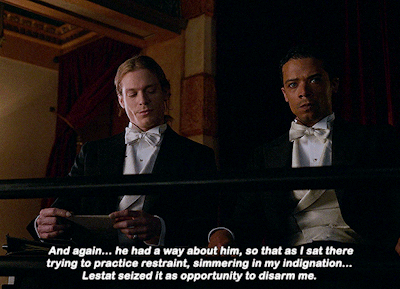
See the little micro-expressions on Samstat's face, when he double-takes? He sits in blissful white privilege, b4 remembering: Oh right! My black husband's just been mistreated by white society AND ME; lemme butter him up by making it all about ME again, trauma-dumping a whole monologue on how lonely I've been on him. 🥺
Works every time. 😉👍
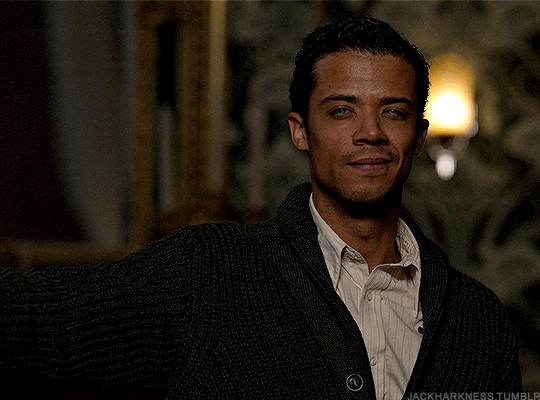
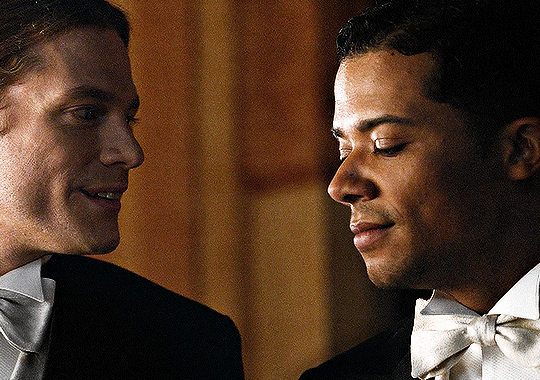
Lestat, an idiot, thought all black!Louis needed to do was act like Lestat a white man, and all his problems would be solved. By embracing his vampire powers, he could go & do what he wanted. But we see in Ep3 precisely what would've happened if Louis decided to REALLY be Lestat's "companion in the Dark Gift, finally." Killing the racist Alderman was just one domino in a string of factors that sparked the race riots, but Louis blamed himself anyways, quick to shoulder the guilt for things beyond his control, and LEFT Lestat.
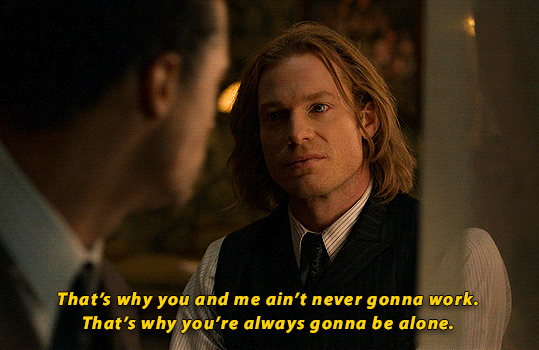
Louis wants to be a "good" Negro, not rock the boat (even if inside Pyromaniac du Lac's boiling mad). Lou'd rather have racists learn to respect him & treat him equally, not go kill all of them, ruling over a pile of corpses. He's not the type to insist on walking side-by-side w/ Les into the Opera House, or sit beside him on the bus. Lou's passive/submissive, he's not an activist. When he "acts out," as Armand called it, it just leads to chaos--riots, the "Great Conversion/flying vampire apocalypse," the Theatre burned down. Lou's a hermit crab in his shell--he shuts down, hides away, full of regret & "self-loathing." He can't be devil-may-care Les & eff-the-police Claudia; that's NOT the type of person he is, or who Les wanted him to be--eff that sword-cane; every time Lou used it he was MISERABLE!
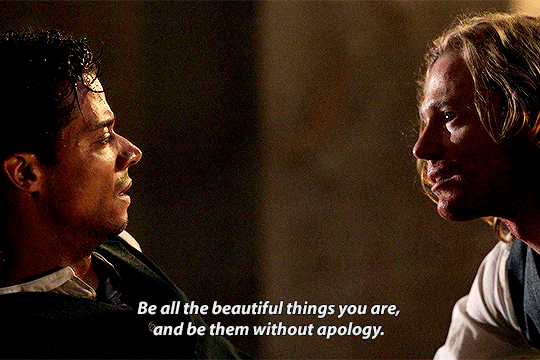
Bull-frikkin-sh!te. 😠

Lestat's selfish, arrogant, cocksure, and toxic AF. And Louis was unequipped to handle him (cuz they're UNEQUAL), loving Les despite all his faults, to the point of LITERAL self-destruction. Rolin & Sam have said many times that Les had yet to be HUMBLED. The world/reality only hit him in Ep7 that the very things he underestimated would be his undoing--Claudia got the jump on him back in Ep6's chess game, and offed him through poisoning Tom (another person Les didn't expect to hurt him). (We'd see this over & over again in the books, as Les got his arse handed to him by people he'd looked down on, from Armand in TVL, to some rando old AF human Raglan James in TotBT, to Rhoshamandes in the PL Trilogy.)
Most importantly, Louis has significant power over Lestat, too. The crazy part's that Les SAW Lou coming inEp7--he KNEW Lou was a garbage liar & was plotting w/ Claudia; he's too obvious--and STILL underestimated Lou. He LET Louis get away with crap, cuz he thought it was harmless, or just not worth confronting Louis about--biding his time & waiting. That's what Les had done for YEARS, with everything from Louis' vegetarianism, to running the Azalea's sinking ship, to sitting at the back of the bus.
"Same thing with the bus. Would he have rather had his family sit upfront with him? Why did he decide to sit in the back of the theater with Louis & Claudia? Is it because it was dark?"
Eff that bus. Lestat would've rather have had Louis (& Claudia) strong enough to use THE CLOUD GIFT. Buses are for weak AF humans who can't take to the air like strong vampires can, and FLY.



Les said in TVL that he held back with Louis, and kept from showing him even half of what vampires could REALLY do--which is why Louis was STUNNED to see the Theatre & Armand & Santiago (a vampire YOUNGER than Louis!) in action.
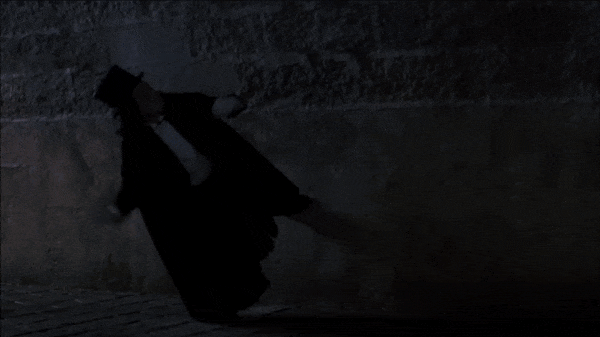
Poor baby bird had no idea. Cuz Louis had been trying so hard & so long to be human, not vampire--he'd stunted his own growth, which is why both Lestat & Claudia looked at him like he was crazy. "A fish that doesn't swim; a bird that doesn't fly. You're going to STRUGGLE." And the scary fact was that Lestat would struggle, too, pretending to be human and not a monster to accommodate Louis: "I'm trying to restrain myself!" 💀
#lestat de lioncourt#interview with the vampire#loustat#white privilege#racism#racial inequality#iwtv tvc metas
23 notes
·
View notes
Text

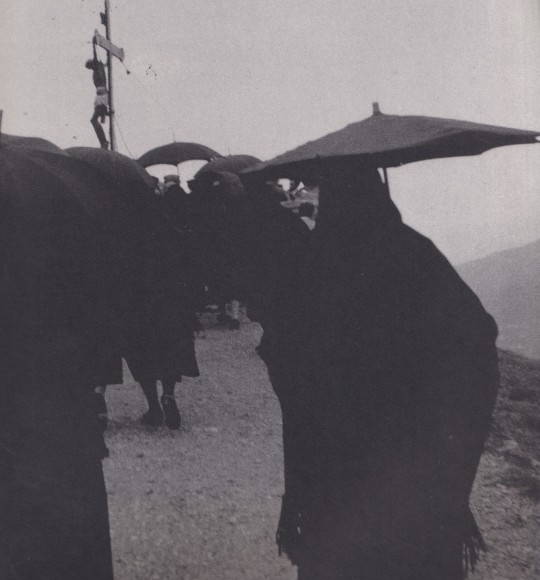
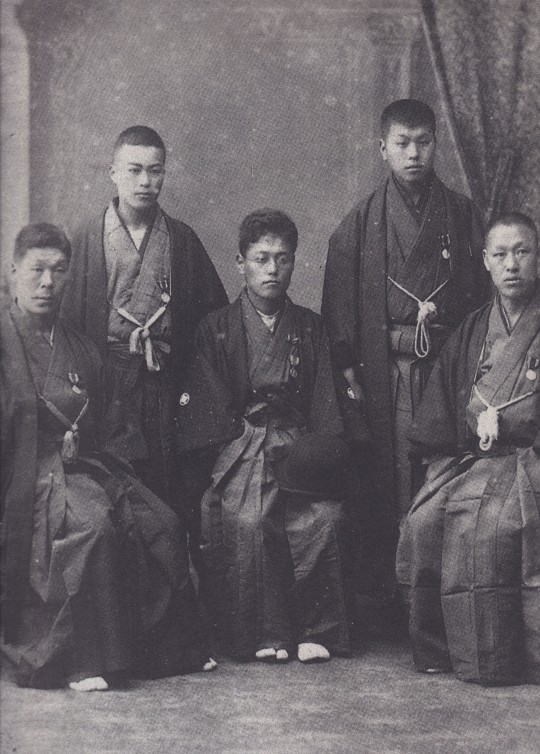


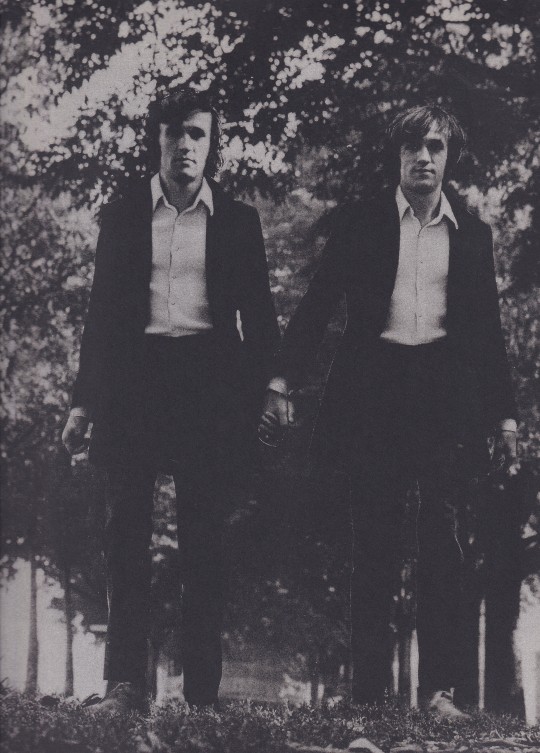
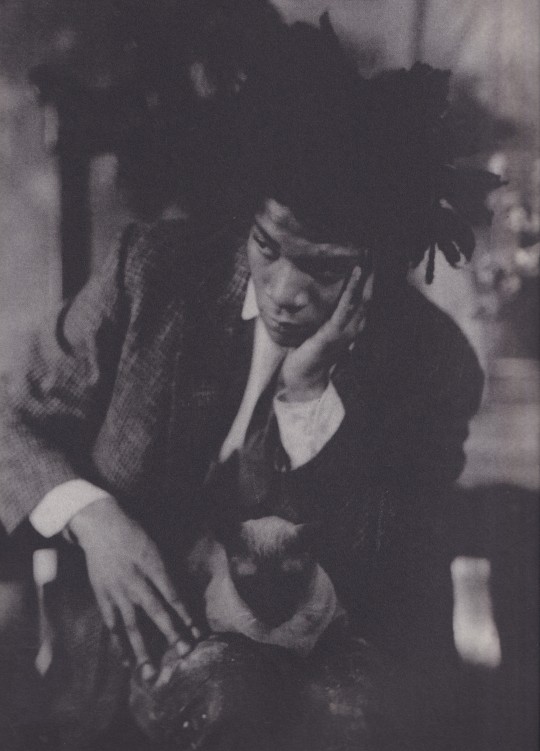
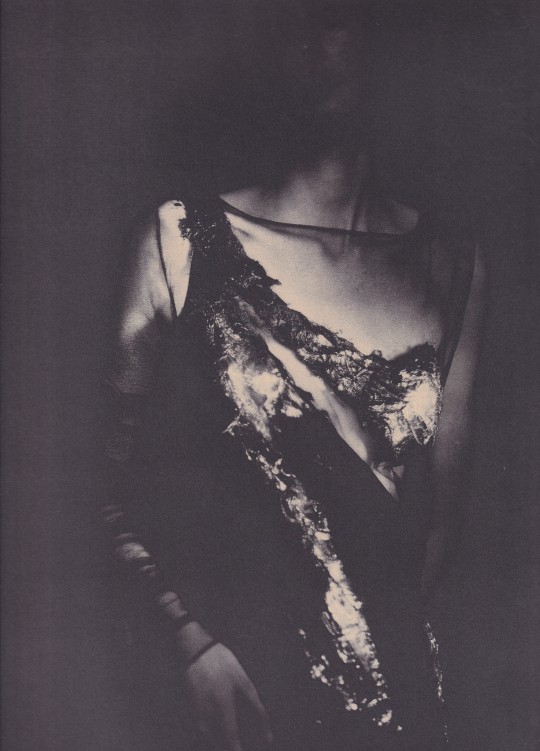


A Noir
Progetto Franca Sozzani , Direzione Artistica Luca Stoppini
Curatori Mariuccia Casadio e Pasquale Leccese
Assouline, Paris 1998, 174 pagine, 26x34cm, ISBN 2843230691
euro 80,00
email if you want to buy [email protected]
Editor-in-chief of Italian "Vogue", Franca Sozzani created this cutting-edge album as an accompaniment to the exhibition "A Noir", organized on the occasion of the Milan Trienniale in 1998. The theme "black" is the starting point for the presentation of a startling series of works by leading artists, fashion designers, photographers, architects and interior designers. From Louise Bourgeois to Damien Hirst, Rei Kawakubo to Rifat Ozbek, Mapplethorpe to Paolo Roversi, Andree Putman to Jean-Paul Goude, each featured artist reveals his or her personal interpretation of the color black, forming an anthology of images. The album includes a collection of essays and a glossary exploring the use and symbolism of black not only in art, photography and fashion, but also in literature, film and music.
12/04/24
#A Noir#Franca Sozzani#Luca Stoppini#exhibition catalogue#Triennale 1998#Louise Bourgeois#Damien Hirst#Rei Kawakubo#Ozbek#Mapplethorpe#Roversi#Goude#Andrée Putman#fashionbooksmilano
5 notes
·
View notes
Text
Mercedes Starbucks to install open-to-all EV chargers along 5 Freeway
EV drivers braving Interstate 5 will soon get a chance for a double charge — electrons for the car, caffeine for the driver.
Starbucks and Mercedes-Benz on Wednesday announced a partnership to install fast electric vehicle chargers at 100 Starbucks cafes along the freeway, starting in 2025. It’s part of a plan to install hundreds of chargers at EV hot spots across the U.S. Although the chargers will carry the Mercedes-Benz brand, they’ll be open to all EVs.
Californians consider the 5 Freeway the quickest (if least beautiful) way to drive up and down the state. The 5 runs through the Central Valley and is the only interstate highway that connects Mexico and Canada, from Tijuana and Vancouver through California, Oregon and Washington. How many stations will be installed in California and at which Starbucks locations, the companies would not say.
Aggressive and impactful reporting on climate change, the environment, health and science.
Each location will have four to 10 EV fast chargers, rated up to 400 kwh and fitted with NACS nozzles, the same kind Tesla uses. NACS is fast becoming the industry standard. But the chargers will be fitted with CCS nozzles too. And they’ll accommodate increasingly popular 800-volt battery architectures.
Although the two brand giants are bound to attract attention, the pressure to perform will be intense. The reliability of publicly available EV chargers is abysmal, and even though the industry is trying to improve, it’s got a long way to go
Several studies have shown up to 25% of public chargers out of order. Although some of those studies are years old, a recent survey by J.D. Power said that customer perception of reliability continues to worsen.
A reliable system could boost traffic for Starbucks and increase Mercedes-Benz brand awareness for EV drivers. If the quality doesn’t exceed the current charging experience, though, it could damage both brands.
Mercedes-Benz said it is taking measures to ensure 99% reliability and will be hiring inspectors to drive around to make sure chargers are working and fix them quickly if they’re not. “Quality will be a guarantee, not a gamble,” said Andrew Cornelia, head of Mercedes-Benz’s charger arm.
Carleen Cullen, an EV advocate who runs an organization called Cool the Earth, has been critical of the public charging infrastructure but said she’s “super excited” about the Starbucks-Mercedes news. “This sort of advancement is exactly what we need in the industry. Putting chargers where people shop and eat, it’s the perfect solution.” Having two companies with their brand image at stake helps too, she said.
Mercedes-Benz will buy its chargers from two companies, ChargePoint and Alpitronic. ChargePoint, a company with a relatively new chief executive that’s trying to climb out of a bad reputation. Mercedes-Benz said it’s happy with ChargePoint’s technology.
It was the original ChargePoint business model, though, that got it into trouble. It worked this way: The company received millions from the state of California in subsidies and sold its chargers to retail and other businesses that also received millions in state subsidies.
ChargePoint then charged those buyers for maintenance contracts. But many of those businesses didn’t want to pay extra, angering drivers who showed up to ChargePoint chargers that didn’t work.
That business model worked great for ChargePoint executives. The previous chief executive, Pasquale Romano, issued stock through a so-called special purpose acquisition company and made millions. The California Energy Commission, which handed out the subsidy money, is considering ways to make subsidy recipients more accountable.
Mercedes-Benz wouldn’t say how much subsidy money it might receive, although it probably qualifies for state funding and for some of the $7.5-billion charging infrastructure program passed by Congress and managed by the Biden administration.
The company also declined to discuss pricing.
Source link
via
The Novum Times
0 notes
Text
Roma. Siglato l'accordo sulla prevenzione e contrasto dei crimini informatici.
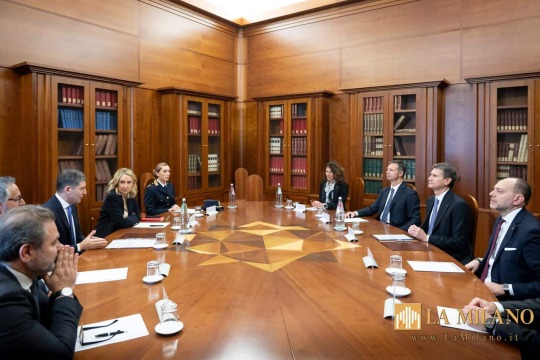
Roma. Siglato l'accordo sulla prevenzione e contrasto dei crimini informatici.
È stato siglato a Roma l'accordo tra la Polizia di Stato e BCC Banca Iccrea, capogruppo del Gruppo BCC Iccrea, per la prevenzione e il contrasto dei crimini informatici che hanno per oggetto le reti e i sistemi informativi di supporto alle funzioni istituzionali della società.
La convenzione, firmata dal Sig. Capo della Polizia - Direttore Generale della Pubblica Sicurezza Prefetto Vittorio Pisani e da Mauro Pastore, Direttore Generale di BCC Banca Iccrea, è finalizzata a sviluppare una collaborazione strutturata tra le parti, per l'adozione ed il potenziamento di strategie sempre più efficaci in materia di prevenzione e contrasto al cybercrime, considerato il delicato e strategico settore di intervento del Gruppo.
Il Gruppo BCC Iccrea è il maggiore gruppo bancario cooperativo, l'unico gruppo bancario nazionale a capitale interamente italiano e il quarto gruppo bancario in Italia per attivi. BCC Iccrea, in qualità di Capogruppo esercita le attività di direzione, coordinamento e controllo sulle Società del Perimetro di Direzione e Coordinamento e, in tale ambito, supporta l'operatività bancaria delle BCC, fornendo prodotti, servizi e consulenza al fine di soddisfare le esigenze dei loro Soci, clienti, famiglie e territorio di riferimento.
La tutela delle infrastrutture critiche informatizzate di istituzioni e aziende che erogano servizi essenziali è una delle mission specifiche della Polizia Postale, l'articolazione specialistica della Polizia di Stato deputata alla prevenzione e contrasto della criminalità. La Polizia di Stato assicura attraverso la Polizia Postale e delle Comunicazioni, Organo del Ministero dell'Interno deputato alla sicurezza delle comunicazioni. In particolare, tale compito viene assolto attraverso il Centro Nazionale Anticrimine Informatico per la Protezione delle Infrastrutture Critiche (CNAIPIC) che, con una sala operativa disponibile h24, rappresenta il punto di contatto per la gestione degli eventi critici delle infrastrutture di rilievo nazionale operanti in settori sensibili e di importanza strategica per il Paese.
Alla firma della convenzione erano presenti per il Dipartimento della Pubblica Sicurezza, il Direttore Centrale per la Polizia Stradale, Ferroviaria, delle Comunicazioni e per i Reparti Speciali della Polizia di Stato, Prefetto Renato Cortese, il Direttore del Servizio Polizia Postale e delle Comunicazioni, Dott. Ivano Gabrielli mentre per BCC Banca Iccrea erano presenti Renato Alessandroni, Responsabile Sicurezza e Continuità Operativa, Chief Information Security Officer, Pasquale De Rinaldis, Responsabile Sicurezza delle Informazioni, Giuseppe Cardillo, Head of Architecture & Innovation e Raffaella Nani, Responsabile Comunicazione Istituzionale....
#notizie #news #breakingnews #cronaca #politica #eventi #sport #moda
Read the full article
0 notes
Photo
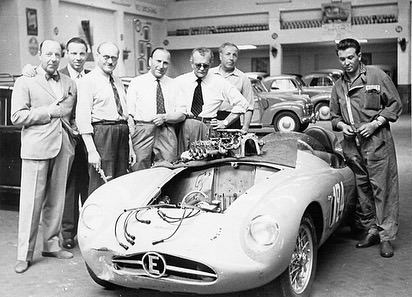
In anticipation of @devinsportscarsllc making a major splash at the Amelia Island Concours this weekend, let’s explore the origins of Bill Devin’s inspiration for his fantastic cars, of which there were 27 different varieties! The excerpts and photos come from an article from VeloceToday in 2014 titled: Devin’s Father: The Ermini 357 “Pasquale Ermini (1905-1958) aka ‘Pasquino’ was a former driver and pre-war racing mechanic of great experience. He started his career when he was 21 years old in Emilio Materassi’s workshop in Florence. Materassi was running his own racing team, Scuderia Materassi, using Talbot and Bugatti GP cars and soon Pasquino became chief mechanic of the team. In 1932, with the death of Emilio, the team was liquidated and Pasquino set up his garage in Via Campo d’Arrigo in central Florence devoted to tuning and preparing racing cars for the great racing events of the period. At the end of WW2 he moved the premises to Viale Matteotti and in 1946 started to build racing cars and engines carrying his own name. Like many of his contemporaries, Pasquale Ermini used FIAT components for his limited edition sports-racers, which were mainly intended for competition in the popular 1100cc class. Typically, Ermini’s own cars used a tubular chassis designed by Gilco (Gilberto Colombo) and were powered by engines using the FIAT 1100 cylinder block. From 1946 to his death, Ermini built 39 cars, most of them 1100 cc with sport and a couple of coupe bodies. All the bodies in aluminum were made by local skilled artisans like Valenti, Mariani and even by Motto in Turin. There was also a pretty Frua-bodied 1300 Coupé presented at the 1953 Turin Show that never went into normal production. In 1955 Ermini made his last model, the ‘tipo 357 barchetta’. As previously said, many different body styles adorned Ermini chassis, but three 357 were clothed by the famous Carrozzeria Scaglietti firm which would later be devoted almost exclusively to Ferrari. There’s no coincidence that the 357 resembles the Ferrari 121 LM of the same year. Bill Devin liked the shape so much, he took molds of the design and copied it for his fiberglass bodies.“ (at The Amelia) https://www.instagram.com/p/CpScGIjLak2/?igshid=NGJjMDIxMWI=
1 note
·
View note
Text
Mercedes-Benz Plans to Build U.S. Electric Car Charging Network

Mercedes-Benz announced Thursday that it will set up a network of more than 2500 high-powered chargers across the United States by 2027, an indication that the German automaker has stepped up its involvement in electric vehicles, taking a page from Tesla's blueprint.
Fast chargers which are distributed across 400 stations are operated beneath the Mercedes brand. The owners of Mercedes' vehicles will enjoy a higher rate of access but the network will also be accessible to vehicles from other manufacturers.
Tesla began to build charging stations in the past and this network has been vital to the success of the automaker by easing the anxieties of buyers who don't have enough charging stations to plug their vehicles into and end up at the side or on the side of the road. These U.S. fast chargers work only for Tesla automobiles, but Tesla has stated that it's going to open up this network up to different brands.
Mercedes's proposed charging network is an indication that Mercedes, which has been unable to retain customers from Tesla and is now determined to make electric cars a reality. The company launched the first battery manufacturing facility located in Alabama and started building an electric vehicle for sport and utility, called the EQS in its facility close to Tuscaloosa, Ala.
If it's completed Mercedes's network is just one-third the size as Tesla's currently. However, it is far more ambitious than those undertaken from other traditional automakers. Electrify America has 3,400 fast chargers in 790 locations across the United States, but does not prominently showcase the Volkswagen brand, even since it is the German company was the one who founded the network and is the owner of a large portion of the company.
"This is a strategic decision to put our money where our mouth is," Ola Kallenius who is the chief executive officer of Mercedes-Benz said to reporters on Thursday.
The company, which is already as a partner of Ionity the European charger network plans to put Mercedes-branded charging stations in Europe as well as China but it is starting in the United States.
Mercedes will share the costs of the network by partnering with MN8 which is a solar energy producer who will provide power to the stations. Mercedes and MN8 have announced plans to seek federal subsidies for companies who build chargers.
Mercedes owners can now reserve time for charging on the internet, and it is made to work in conjunction with Mercedes automobiles, meaning that drivers will not have to do anything else than connect their vehicle to the network.
Charges and payments "all happens under the covers, in an invisible way," Pasquale Romano, director of ChargePoint the maker of chargers that supply chargers to Mercedes the company, told reporters on Thursday.
The automaker will begin making charging hubs later in the coming year. The gadgets will be able to pump energy into automobiles at 350 kilowatts each hour, which is much more than charging stations typically found within the United States.
These hubs are located close to restrooms and restaurants Mercedes stated, such as near malls with luxury amenities that frequent Mercedes' wealthy customers. The hubs will feature security cameras to monitor the premises.
Mercedes is working to address complaints from electric vehicle owners who are afraid to use chargers in remote areas. They will place the hubs placed in "a safe location," Markus Schafer, the chief technology officer at Mercedes told reporters, "not in the backyard of a shopping center next to the dumpster."
Read the full article
0 notes
Photo

Today is National Wreaths Across America Day, where Remember, Honor and Teach about its importance. It is carried out by coordinating wreath-laying ceremonies at Arlington National Cemetery, as well as at more than 3,400 additional locations in all 50 U.S. states, at sea and abroad. This was in 2016 where I carried the Coast Guard wreath alongside Chief Warrant Officer I’ve been outside, no cap 🧢. Scroll —> History: During the Mexican-American War (1846-1848), a handful of small battles were fought in Southern California. On December 6-7, 1846, a combined U.S. force of soldiers, sailors, and marines under the command of General Stephen Kearny engaged a small group of Californios (Mexican colonists) in the Battle of San Pasqual, about 30 miles north of San Diego. Eighteen of Kearny's men fell in the battle, but U.S. forces managed to hold the field and win the war. The Treaty of Guadaloupe Hidalgo, signed in February 1848, established the border between the two countries 15 miles south of San Diego. California became a state too. A large resident veteran population and limited burial capacity at nearby Fort Rosecrans National Cemetery-so designated in 1934 but associated with an older post cemetery-was the impetus for building a new national cemetery in the area. In 2008, MCAS Miramar leased land in perpetuity to the National Cemetery Administration to develop Miramar National Cemetery. Approximately one-third of this 313-acre property is reserved to protect federally endangered or threatened species-including the San Diego fairy shrimp, California gnatcatcher, Otay mesa-mint and San Diego button-celery. Miramar National Cemetery was dedicated in January 2010, and the first burial occurred on November 22 that year. (at Miramar National Cemetery) https://www.instagram.com/p/CmRupsjJHPi/?igshid=NGJjMDIxMWI=
0 notes
Text
humans animatronics are sure something



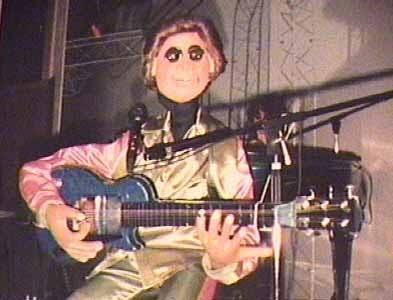





#chuck e cheese#pizza time theatre#showbiz pizza#rock afire explosion#animatronics#irl animatronics#pasqually the chief#pasqually p pieplate#family album#uncle klunk#this is not hate btw#i like all of them#i watch the beat it cover by the family album and its very good#and uncle klunk demo showtape is also cool
214 notes
·
View notes
Photo

Virdimura was a XIVth century Sicilian Jew living in Catania and married to Pasquale, himself a Jew and physician (“Virdimuram ludeam uxorem pascalis de medico de cathania ludei servi camere nostre”). Even though news about Virdimura’s life are very scarce (we don’t know, for instance, when she was born or died), it can be claimed she was the first woman to be officially authorized to practice the medical profession in Sicily (“licenciam praticandi in sciencia medicine circa curas phisicas corporum humanorum”). It wasn’t, in fact, uncommon during the Middle Ages that a woman (wife or daughter or sister) learnt medicine from their male relatives and were often asked to unofficially perform medications and prepare medicaments off secret family recipes, to the point we can talk about actual medical dynasties. Until the middle of the XVth century, Jewish doctors made up the majority of the Sicilian medical personnel since many Sicilian Christian doctors had migrated towards Salerno and other Northern Italy cities. Sicilian Jews could speak Latin, Greek, Hebrew and Arabic and this ability facilitated them in the study of medical treatises. Starting XIII-XIV women were able to attend universities courses, and (talking about the Kingdom of Sicily) were welcomed at the Schola Medica Salernitana and the University of Naples. The only thing that distinguished a woman from her male Christian colleagues was that she couldn’t boast the title of doctor since (according to Christian jurists) nor women nor Jews possessed the dignitas, such as the legal capacity to exercise autorictas. That meant they could practice medicine (and reached the level of magister), but not teach it. Moreover, according to the Sicilian constitution of 1310, Jewish doctors couldn’t treat Christian patients lest they would be sentenced to a year in jail and forced on bread and water, while the patient’s detention would last three months (although some of these Jewish doctors became court physicians and treated sovereigns and even Popes and members of the clergy).
Back in 1134 and 1140, Ruggero II of Sicily had regulated that nobody could practice the medical profession without authorization and in 1224 Federico II decreed that the candidate needed to be previously authorized by an official commission of doctors of the Schola Medica Salernitana before practising medicine. An official document dated November 7th 1376 attests that Virdimura, was indeed tested by the Chief Physician of Sicily (the Dienchelele), who awarded her the medical licence, which she could practice in the entire territory of the Kingdom of Sicily (“ubique locorum dicti regni nostri Sicilie”). The document states that, even before passing the medical test, Virdimura was already universally praised (“qui eamdem virdimuram previa examinadone predicta. ac suadente fama laudabili”) and that she used to treat those people who couldn’t afford to pay doctor’s high fees (“maxime pauperum quibus dificile censetur immensa phisicorum et medicorum salaria solvere”).
Despite being a rather unknown historical figure, Virdimura is still nowadays celebrated with the creation of a “Virdimura Award”. Created in Catania in 2013, this international award honours all those women who, aside from practising medicine, have devoted their lives to helping their neighbours.
Bella di Paija was a XVth century Sicilian Jew living in Mineo (nearby Catania), home to one of the most active Sicilian Giudeccas between the XIV-XVth centuries. Like for Virdimura, news about Bella’s life are pretty much nonexistent. We know though that she was married and had unofficially practised medicine for decades before being officially licensed to perform surgeries.
Unlike Virdimura, who had to petition to be judged by the committee to receive her permission (“Cum ad humilem supplicacionem factam novicer excellencie nostre”), Bella was personally licensed through a royal decree on September 6th 1414 by the Regent Blanca of Navarre, who had been informed by trusted persons about Bella’s long and successful career (“havi patricatu et exerzuta l’arti di la celurgia in la quali si havi ben portatu, cum sanitati di li pacienti”). Bella could now officially practice surgery (“in qualsivoglia infirmitati di celurgia”) in all the territories part of the Camera Reginale (the dowry Sicilian Queen consorts received upon marrying and consisting on the fieffs of Paternò, Mineo, Vizzini, Castiglione di Sicilia, Francavilla di Sicilia, Siracusa, Lentini, Avola, the village of Santo Stefano di Briga, the island of Pantelleria, and Castle of Maniace in Siracusa). Another difference between the two physicians was that, differently from Virdimura, Bella and her husband were exempted from paying taxes and shouldn’t suffer any kind of harrassment (“liberi et exempti di omni angaria, perangaria, collecti, imposicioni”). Female Jewish physicians (licensed or not) were particularly appreciated, especially by their fellow female patients (who made up the majority of their clientele) and were considered experts in obstetrics and in general all those diseases and issues which concerned the female body. Apart from treating broken bones, sewing up wounds and perform small operations, these medichesse were very often asked to restore through plastic surgery the virginity of those Jewish women who had had sexual intercourses prior the marriage and were afraid to be repudiated once their future husbands had discovered they were no longer virgins. They also gave advices concerning birth control and assisted their patients in case of abortion, or during their pregnancy and at the moment of the birth. It must be pointed out that, unlike their Christian colleagues, since XIIth century Jewish physicians stressed the importance of washing their hands before treating a patient, anticipating thus the discovery of XIXth Hungarian physician Semmelweis.
Sources:
- BELFIORE G., Le medichesse, l’importante ruolo delle ebree in Sicilia;
- FASANO G., L’incredibile storia di Virdimura e delle altre medichesse siciliane;
- FRISCIA V., Bella de Paija e Virdimura de Medico: due medichesse catanesi;
- LAGUMINA G. - LAGUMINA B., Codice diplomatico dei giudei di Sicilia, vol. I-part I;
- LEONE A., Medici e Medichesse ebrei nella Sicilia del 1400;
- POTTINO P., Virdimura, la “dutturissa” che sfidò i preconcetti nella Sicilia medievale;
- PRECOPI LOMBARDO A., Virdimura, dottoressa ebrea del Medio Evo siciliano;
- SANTORO D., La cura delle donne. Ruoli e pratiche femminili tra XIV e XVII secolo in Memoria, storia e identità. Scritti per Laura Sciascia;
- STRANGES P., Premio Virdimura a Corinne Devin, da Miss Stati Uniti ai Marines;
- TAITZ E. - HENRY S. - TALLAN C., Jps Guide to Jewish Women;
- VENTURA D., Medici Ebrei a Catania
#women#history#history of women#women in history#historical women#virdimura#bella di paija#province of Catania#catania#mineo#aragonese-spanish sicily#people of sicily#women of sicily#myedit#historyedit
88 notes
·
View notes
Photo

Hendrik Kobell - Portrait of general Pascal Paoli - 1768
Filippo Antonio Pasquale de' Paoli FRS (French: Pascal Paoli; 6 April 1725 – 5 February 1807) was a Corsican patriot, statesman and military leader who was at the forefront of resistance movements against the Genoese and later French rule in the island. He became the president of the Executive Council of the General Diet of the People of Corsica, and also designed and wrote the Constitution of the state.
The Corsican Republic was a representative democracy asserting that the elected Diet of Corsican representatives had no master. Paoli held his office by election and not by appointment. It made him commander-in-chief of the armed forces as well as chief magistrate. Paoli's government claimed the same jurisdiction as the Republic of Genoa. In terms of de facto exercise of power, the Genoese held the coastal cities, which they could defend from their citadels, but the Corsican republic controlled the rest of the island from Corte, its capital.
Following the French conquest of Corsica in 1768, Paoli oversaw the Corsican resistance. Following the defeat of Corsican forces at the Battle of Ponte Novu he was forced into exile in Britain where he was a celebrated figure. He returned after the French Revolution, of which he was initially supportive. He later broke with the revolutionaries and helped to create the Anglo-Corsican Kingdom which lasted between 1794 and 1796. After the island was re-occupied by France he again went into exile in Britain where he died in 1807.
Hendrik Kobell (13 September 1751 – 3 August 1779) was an 18th-century landscape and marine painter, etcher, draftsman and watercolorist from the Northern Netherlands.
He came from a painting family and was a cousin of Ferdinand Kobell and Franz Kobell, German painters and brothers. His father was a pottery merchant, and though he was not a professional artist, he trained his son in drawing, who loved to draw ships in the port of Rotterdam. The younger Kobell was finally able to take a journey in one when his father arranged some business he could attend to in London in 1779. There he conducted his business while drawing all sorts of ships and boats, and when he returned to the Northern Netherlands in 1770, he gave up the pottery business to study art in Amsterdam. He studied for two years under Jacob de Vos and Cornelis Ploos van Amstel with such success that he was elected a member of the Stadstekenacademie (Amsterdam drawing academy). He travelled to Paris in 1772 and in 1772 settled in Rotterdam, where he helped set up a similar drawing academy; Genootschap Hierdoor tot Hooger.
He painted in oils and watercolors, doing landscapes and marines. His work is distinguished by skillful manipulation and lifelike depiction. His work as a draftsman and etcher was also notable. He was esteemed for his numerous drawings, executed in pen and heightened with India ink.
He was the father and teacher of the painter Jan Kobell II (1778–1814), and his other pupils were Carel Frederik Bendorp, and Gerrit van der Pals.
5 notes
·
View notes
Text
A history of Columbus Day and the New Orleans Lynchings
“A lot of people don’t really have a good understanding as to why we used to celebrate Columbus Day or it’s true history. Now I’m not going to use this opinion to talk about modern Columbus Day or Indigenous People’s Day, that’s not relevant to this at all. This about the history of the event that started Columbus Day, the March 14th New Orleans lynchings.

So back in 19th century America, there was a massive prejudice against Italian Americans. There was a large amount of immigrants coming to the southern states, many moving into the French Quarter of New Orleans. Now, this wasn’t just prejudice, this was full-on hatred. To quote New Orleans mayor Joseph A. Shakspeare, “the worst classes of Europe: Southern Italians and Sicilians...the most idle, vicious, and worthless people among us...filthy in their persons and homes... without courage, honor, truth, pride, religion, or any quality that goes to make a good citizen."
Yikes.
Things came to a boiling point when New Orleans police chief David Hennessy was shot by a group of unknown assailants. When asked by detectives about who’d shot him, David Hennessy only replied with “Dagoes”. (Dagoes was at that point in history a slur against or Italians and others of Mediterranean heritage). Things were made worse by the Times-Democrat and the Daily Picayune said that “dagoes” were responsible for the murder. Others blamed the Provenzano and Mantranga families, as Hennessey had arrested their members before. Mayor Joseph A. Shakspeare, as supposedly quoted by the Daily Picayune gave the order to, "scour the whole neighborhood. Arrest every Italian you come across.". About 250 people were captured and 45 were arrested.
Nine of the suspects were taken in for trial, which began on February 16, 1891 and ended on March 13, 1891. However, evidence was flimsy for the nine men, and all of them were released and faced no charges. The jury, who was made of people not opposed to capital punishment, were not openly prejudiced against Italians, and were not Italian or shared Italian heritage. When the jury left, they were met by an angry crowd, with some of them losing their jobs or being arrested on flimsy charges. The mayor declared Hennessy was "the victim of Sicilian vengeance" and calling upon people to "teach these people a lesson they will not forget."
A group calling themselves the Committee on Safety, made of 150 citizens, made a plan for retaliation. Some members of this mob were John M. Parker (friend of Theodore Roosevelt and future governor of Louisiana) and Walter C. Flower (future mayor of New Orleans). Before the massacre took place, Pasquale Corte, the consul of Italy, attempted to get Francis T. Nicholls, the current governor of Louisiana, for help. However, Francis T. Nicholls was busy getting breakfast at the time and wasn’t interested in helping. A letter was written by the Committee, with the letter ending on a menacing note, “We hope this appeal will be met by you in the same spirit in which we issue it, and that this community will not be driven to harsh and stringent methods outside of the law, which may involve the innocent and guilty alike...Upon you and your willingness to give information depends which of these courses shall be pursued.”
Gathering outside the Parish Prison, the Committee on Safety attacked the building with battering rams. The guards warned the Italian prisoners of what was coming and allowed a few of them to hide. When the mob broke inside, they killed eleven men. Emmanuele Polizzi, a mentally ill man, was hanged outside on a lamppost and shot multiple times. Antonio Bagnetto, who had been acquitted, was hanged from a tree and shot. Nine other men were shot and clubbed to death, their bodies left out for hours.
When the mob was caught, most of the officers knew many of the people involved with the lynching. A grand jury was called on March 17, 1891 to investigate, but their findings were quite different to what happened. The report called the mob a “gathering" of "several thousands of the first, best, and even the most law-abiding, of the citizens of this city.". Not one member of the mob was indicted. Eight more Italian men would be lynched in the coming months.
Pasquale Corte left New Orleans and wrote about the incident and accused the city politicians for stoking the flames. The Italian Government wanted America to convict the lynch mob and recalled its ambassador from Washington, America responded by recalling their ambassador from Rome. There was even rumors of a coming war between America and Italy over the incident. Even future preisdent Teddy Roosevelt (yes, that one) made his own comments about the lynching to his sister, “Monday we dined at the Camerons; various dago diplomats were present, all much wrought up by the lynching of the Italians in New Orleans. Personally I think it rather a good thing, and said so.”
Benjamin Harrison, the current President at the time, decided to placate the Italian government and Italian Americans by creating the first national Columbus Day. This seemed to work as relations with Italy mellowed out after the day’s implementation. But even then some prejudice against Italian Americans still remained through the 1890′s. The word “mafia” was introduced to American vocabulary at the time, and the phrase “Who killa de chief?” was popular amongst children.
This post was not meant to justify the modern celebrations of Columbus Day or the debate between Columbus Day and Indigenous People’s Day, just to talk about the tragic history and events that lead to the creation of Columbus Day. Some people know of the origins of Columbus Day but don’t quite understand the events that happened, this post was to teach history. I also recommend Vendetta: The True Story of the Largest Lynching in U.S. History by Richard Gambino and its 1999 HBO movie adaptation Vendetta.
#history#italian american history#columbus day#indigenous people's day#itay#american history#true events#new orleans#louisiana#rememberance#sad#sad history#true history#columbus
5 notes
·
View notes
Photo










A Noir
Livre Noir. Art et Mode
progetto Franca Sozzani, direzione artistica Luca Stoppini
curatori Mariuccia Casadio,Pasquale Leccese
Assouline, Paris 1998, 176 pages, Broché, 34x27,6x1,8cm, ISBN: 978-2843230707
euro 90,00
email if you want to buy :[email protected]
Editor-in-chief of Italian “Vogue”, Franca Sozzani created this cutting-edge album as an accompaniment to the exhibition “A Noir”, organised on the occasion of the Milan Triennial in 1998. The theme “black” is the starting point for the presentation of a startling series of works by leading artists, fashion designers, photographers, architects and interior designers. From Louise Bourgeois to Damien Hirst, Rei Kawakubo to Rifat Ozbek, Mapplethorpe to Paolo Roversi, Andree Putman to Jean-Paul Goude, each artist featured reveals his or her personal interpretation of the colour black, forming an anthology of images. The album includes a collection of essays and a glossary exploring the use and symbolism of black not only in art, photography and fashion, but also in literature, film and music.

23/11/21
orders to: [email protected]
ordini a: [email protected]
twitter: @fashionbooksmi
instagram: fashionbooksmilano, designbooksmilano tumblr: fashionbooksmilano, designbooksmilano
#Noir#Franca Sozzani#Luca Stoppini#fashion exhibition catalogue#Triennale Milano 1998#black#art et mode#fashion books#fashionbooksmilano
32 notes
·
View notes
Text
New Post has been published on All about business online
New Post has been published on http://yaroreviews.info/2021/06/ev-startups-are-in-trouble-investors-dont-care
EV Startups Are in Trouble. Investors Don't Care.
Lordstown Motors Corp. RIDE 3.30% , an electric-truck startup, is off to a bumpy start as a public company. In the past month, it said it missed its targets on costs and production, acknowledged it overstated preorders, told investors it didn’t have enough money to start full production and parted with its CEO and CFO.
Yet the company’s investors are rather unfazed: Lordstown’s share price is roughly the same as in mid-May.
The stocks of numerous recently listed electric-vehicle companies are showing remarkable resilience in the face of significant turmoil at their businesses. Lordstown, semi-truck maker Nikola Corp. NKLA -2.94% and electric-car maker Canoo Inc. GOEV 0.40% all have share prices that are in line with, or above, the prices from when they struck deals to go public by merging with special-purpose acquisition companies, or SPACs, last year.
Nikola has a market capitalization of $6.5 billion, up more than 60% since it struck its deal to list last year. Months later, the company’s executive chairman resigned after a short seller accused the company of misrepresenting its technology. The company, which denied allegations of fraud, then scuttled multiple new types of vehicles it previously advertised as key to its business, and a partnership with General Motors Co. largely fell apart.
Canoo announced this spring it dropped numerous aspects of its business plan that it sold to investors months earlier, and its CEO, CFO and co-founder all left the company. It has a roughly $2.4 billion market capitalization, unchanged from when it struck the deal to list publicly. None of the three companies have begun commercial production of vehicles.
Helping explain the seemingly unshakable shares is the flood of amateur investors who bet on stocks of new car makers that went public through SPACs in the past year, analysts and observers of the sector say. Motivated by the promise of fast growth and optimism about an electric vehicle-filled future, these individual investors helped push the shares of numerous new companies in the sector to historically lofty valuations by traditional auto maker standards.
It is unclear exactly how much of the electric vehicle companies’ trading is affected by amateur investors versus hedge funds and Wall Street institutions, which also own some of the stocks. Some traders have placed bets that companies in this sector will drop in value.
The resilience of these stocks has befuddled many watching the industry.
“Normal fundamental and economic analysis would lead you to a pretty dire outcome” for some of the companies, said Jon Lopez, an analyst who covers the new-electric vehicle companies for Vertical Group. But the financial world is awash with money and starved for investments that grow quickly, he said, leading to strange outcomes like this year’s Reddit-fueled rise of so-called “meme stocks” that were boosted by investors who posted calls to send shares of certain companies “to the moon.”
The dynamics at play are similar to Telsa Inc., the electric-vehicle company run by Elon Musk that has more than quintupled in value since early last year to become the world’s most valuable auto maker, said Bradford Cornell, a professor emeritus at University of California Los Angeles’ business school. Tesla’s share price often goes up for little clear reason, while negative events often have little or no impact. Investors are more focused on a future narrative of extraordinary growth than the present day-to-day, he said.
“Is the narrative still believable? If it is, there’s no reason why it can’t go up,” he said of these companies’ stocks.
Lordstown, Nikola and Canoo each have expressed optimism about their businesses, saying they are pointed in the right direction after recent turbulence. Executives at all three have highlighted significant progress even amid their struggles—a development that seems to have tided over investors.
Steve Burns, shown at right with former President Donald Trump in 2020, resigned as Lordstown CEO this month.
Photo: Ken Cedeno/SIPA/Reuters
Lordstown executives said this week they are still on track to start producing some pickup trucks this fall, and demand appears to be strong. The company is in the process of seeking new funding. Nikola has said it is on track to deliver its first electric trucks later this year, and recently struck a deal to raise another $300 million.
Numerous companies in the electric-vehicle industry are “trying to get through SPAC puberty,” said Tony Aquila, Canoo’s chief executive and chairman. After joining the board last year, Mr. Aquila scrapped multiple aspects of Canoo’s business plan, including a plan to rent most customers cars month by month—changes he said he made to bring Canoo’s business in line with what’s achievable. He said he wants to Canoo “underpromise and overdeliver.”
The stocks of Lordstown, Nikola and Canoo are down significantly from their highs, although the same is true for the shares of other electric-vehicle makers, as the market for high-risk stocks has cooled since a burst of enthusiasm late last year. The stocks of the three electric-vehicle makers also haven’t been immune to bad news, but the dips on concerning revelations were less than many analysts expected, and the share prices often recovered many of their losses.
The buoyant environment helped allow a burst of electric-vehicle startups to collectively raise billions of dollars with ease in the past year through mergers with SPACs. They quickly became appealing for early stage startups in hot sectors like electric vehicles; SPACs allow startups to freely talk about their future projections and plans, unlike a more heavily regulated initial public offering.
Lordstown was a prime beneficiary. In its investor presentation from last summer, it highlighted how it would make an electric pickup that would be far less costly than a gas-powered Ford F-150. There was already strong demand from a long list of customers who preordered the truck, the company said, and production would take relatively little investment because the plant Lordstown got from General Motors wouldn’t need much renovation.
Those plans have unraveled.
Share Your Thoughts
What’s your outlook on electric vehicle companies like Lordstown Motors? Join the conversation below.
Costs of outfitting the plant—which was previously used to build a gas-powered sedan—proved far higher than expected. Ford announced an electric F-150 that was priced more than 20 percent lower than Lordstown’s truck. The company acknowledged some preorders were made by prospective buyers who didn’t appear to have the resources to buy the trucks, and said it received a subpoena from the U.S. Securities and Exchange Commission on the issue. Plant costs soared while full-scale production was delayed.
Peter Di Pasquale, a 30-year-old engineer from Pasadena, Calif., first invested in Lordstown in April after reading about it online, believing it would be able to produce a solid truck. He said he’s aware the company has significant risks, and the management tumult in the past week was concerning. Still, the company is nearing production of its pickup, giving it a leg up on other manufacturers that are months or years behind.
“The factory is real,” he said. “The workers are real.”
“I’m cautiously optimistic.”
Write to Eliot Brown at [email protected]
Copyright ©2020 Dow Jones & Company, Inc. All Rights Reserved. 87990cbe856818d5eddac44c7b1cdeb8
1 note
·
View note
Text
Arte Laguna Prize [winner] 16th Edition | Venice, Italy | February 2022
Arte Laguna Prize
16th Edition [winner]
Venice, Italy | February 2022
Arte Laguna Prize, the world’s most influential competition for artists and designers, showcases and promotes creative talent. With 17 years of history, Arte Laguna Prize offers the opportunity to join the huge network of collaborations around the world. Exhibition of the finalist artists in the breathtaking location of the Arsenale of Venice and much more.
FINALIST ARTISTS 21.22
Discover the names of the artists that will exhibit at the Arsenale of Venice from March 11 to April 16, 2023.
The finalists have been selected by the international jury, composed of important curators and directors of museums operating in different countries: Kobi Ben-Meir (Israel – Chief Curator Of Haifa Museum Of Art), Louise Fedotov-Clements (United Kingdom – Artistic Director, Quad & Director, Format International Photography Festival), Pasquale Lettieri (Italy – Curator, Critic, Historian, Academic And Journalist), Alka Pande (India – Consultan Arts Advisor And Curator, Visual Arts Gallery, India Habitat Centre In New Delhi), Danilo Premoli (Italy – Architect, Designer, Artist), Alisa Prudnikova (Russia – Founder, Commissioner And Artistic Director Of The Ural Industrial Biennial).
0 notes
